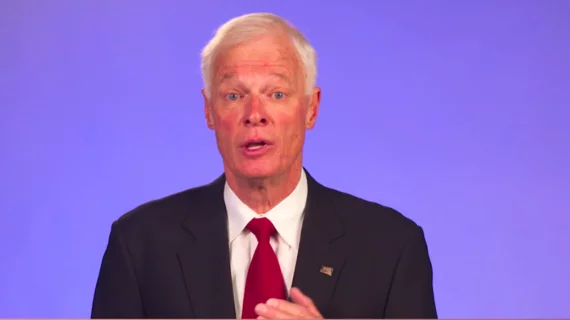Radiologists must lead movement to ‘flatten’ the earth of medicine, RSNA president charges
The COVID-19 pandemic has proven how small the world can be, with physicians across the globe collaborating to understand the novel virus. And radiologists can serve as “stewards” of this flattening in the coming months and years.
That was one of the key messages from RSNA President James Borgstede’s opening address to kick off the society’s annual meeting Sunday. The noted University of Colorado Denver professor labeled 2020 as a “very challenging and perplexing year,” which includes the Oak Brook, Illinois-based group canceling its in-person meeting for the first time since World War II.
Despite these challenges, Borgstede sees tremendous opportunity for the field of radiology, starting starts with embracing collaboration and sharing best practices from around the globe.
“Through the COVID-19 pandemic, we have all seen how flat the world is. For better or for worse, we’re all interconnected; the well-being of one of us affects us all,” Borgstede told attendees Nov. 29. “This lesson is one that we have all learned from the past year.”
He sees “infinite” opportunities for radiologists amid a rapidly evolving technology climate. Global annual patent applications related to medical devices have tripled in 10 years. Technology cycle times are half of what they were just five years ago; and by 2021, the world will have more than three times as many connected devices as people. Yet, two-thirds of the world still does not have access to these advanced imaging methods, according to the Pan American Health Organization.
“But we don’t have to operate in two different healthcare worlds—the highly resourced and the under-resourced,” Borgstede said. “We in radiology are fortunate to have so many resources that make us a worldwide specialty, and I see our resources as ‘flatteners’… to drive globalization and create equal opportunities,” he added later.
Borgstede listed four separate facets in imaging’s drive toward globalization—radiologists themselves, their patients, groups like the Radiological Society of North America, and technology. As artificial intelligence continues to proliferate, some remain concerned that the latter may be coming to take their jobs. But he believes no new algorithm, app or widget will ever assume the element radiologists bring to patient encounters.
“We must remember that our technology can’t achieve the innate humanity of medicine. Technology does not make physicians current, intelligent, ethical, just and honest,” Borgstede said. “These are very human attributes, and they’re needed to care for our patients and direct the future use of technology for their benefit. There is no substitute for human-to-human interaction in radiology,” he added.
The RSNA president closed by challenging fellow radiologists to ask themselves: “How are you encouraging worldwide convergence that benefits our patients?” And he implored peers to stay focused on the specialty’s very promising future, rather than lamenting what’s been lost.
“We must maintain a prospective vision of what can and should be,” he said. “A troubled specialty is one that tells everyone how good things were in the past. We must be a specialty who takes charge of its future, supporting one another and committing to improving the care of our patients, worldwide. We’re a specialty of infinite opportunities, an infinite combination of technology and the human spirit. We must be a specialty whose visions exceed its memories,” he closed.
Watch for continuing coverage of the RSNA’s 106th Scientific Assembly and Annual Meeting throughout this week.

